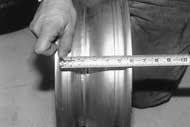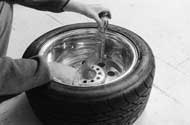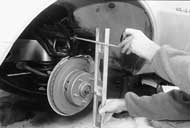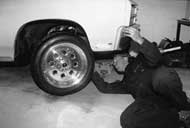 |
"Wrong
wheels." With those two words we’ll easily dismiss a car’s
potential for a feature in the magazine. Perhaps it’s not just the look that’s
wrong--could be right wheels, wrong fit. Tires hangin’ outside the fenders. Too much
room between the rubber and the sheetmetal. Tread so wide you can’t steer. Meats that
are just plain too dinky. Ugly, ugly, wrong, ugly.
Don’t let this happen to you. The wheel-and-tire combo is one of the biggest styling
statements you can make with your car, but blundering on the fitment can wreck any combo.
It’s an expensive mistake, too, since few companies will take back wheels or tires
once they’ve been mounted. Tough as it seems, you have to pick the right rubber the
first time. Our best advice on that score is to borrow some wheels from a friend and try
before you buy. Even if the loaner rollers aren’t the right fit, you can use the
photo captions in this story to help determine the perfect
setup.
Here’s another plus: We found out that Weld Wheels has put a lot of effort into
finding the perfect wheel sizes and backspacing to fit the biggest tires possible for a
number of applications. The company test-fit real-world musclecars with rims from 15 to 20
inches in diameter with varying tires and supplied us with a sampling of the information
for the cars most likely to be owned by Car Craft readers. We decided to print Weld’s
findings for rims up to 18 inches in diameter. Anything bigger is pretty extreme for a
street machine. Before we get into Weld’s specific recommendations, there are a few
caveats. First, the backspacing information will not be accurate if you’ve either
narrowed or widened your rearend, or if you’ve altered the brake system in a way that
will affect the vehicle’s track width. Some aftermarket disc-brake hats are thicker
than stock by as much as half an inch; also, swaps that involve different-than-stock
spindles or control arms may move the wheel-mounting flange inboard or outboard from the
factory location.
Weld tested each fitment for clearance at full jounce and rebound, so the tire/wheel
combos mentioned will fit lowered cars as long as the location of the factory bumpstops
has not been altered. You may run into clearance problems if your steering stops have been
altered from original. Also, the older and sloppier your suspension, the more likely
you’ll run into tire-contact problems thanks to excessive body roll.
Next, we noted that Weld seemed to be going for the widest possible tires; in our opinion,
it’s sometimes better to fill the wheelwells with taller tires at the cost of
slightly skinnier tread width.
Finally, know that Weld did all the fit-checking with its own wheels. Weld’s specs
should work with wheels of any brand, but it’s possible that different manufacturers
either measure or manufacture wheels just differently enough that there could be trouble.
Test-fits were done with both BFG G-Force T/AKD tires and Bridgestone Pole Positions; Weld
reports that, size for size, the BFGs tend to run a tad larger than the Bridgestones. So,
once again, trying it out is your best bet--but this list gives you a very solid place to
start.
1967-1969 Camaros and Firebirds
15-inch:
15x8 with 4-1/2-inch backspacing front and rear. With some tires the rear shocks will have
to be mounted inboard; if you do that, some combinations of 9-inch rear wheels will work
with 5-1/2-inch backspacing.
16-inch: 16x8 with 4-1/2-inch backspacing front and rear. The rear
shocks will have to be relocated inboard. Use tires with an aspect ratio of 50 or less
with section widths of 245 to 255.
17-inch: 17x9 with 5-1/2-inch backspacing front and rear. There
may be lower-control-arm contact with some steering gears. Use tires with an aspect ratio
of 40 or less and section widths of 245 to 255.
18-inch: 18x9 with 5-1/2-inch backspacing front and rear. Use
tires with an aspect ratio of 35 or less with section widths of 245 to 255 in front and
275 in the rear.
1970-1981 Camaros and Firebirds
15-inch:
15x8 with 4-1/2-inch back-spacing up front. Camaros use 15x9 with 5-inch backspacing in
the rear; Firebirds can use 15x10 with 51/8-inch backspacing in the rear. Use tires with
an aspect ratio of 55 or less with widths of 255 front, 285 rear. You’ll need to
remove the outer rear seatbelt anchor/retractor and flatten the bulge in the rear
wheelwell with a hammer.
16-inch: Same as for the 15-inch recommendations but with a tire
aspect ratio of 50 or less. There may be lower-control-arm contact with some steering
gears.
17-inch: 17x91/2 with 6-inch back-spacing up front; you’ll
need to modify the steering stops or the lower control arm to prevent contact. Camaros use
17x10 rears, Firebirds use 17x11, both with 6-inch backspacing. As mentioned in the
15-inch recommendations, you’ll need to remove the seatbelt retractor and bulge. Use
tires with an aspect ratio of 40 or less with widths of 275 front, 295-315 rear. This is a
really tight fit, so success will vary
car-to-car.
18-inch: Use the same recommendations as for the 17-inch rims, but
the tires need an aspect ratio of 30.
1982-1992 Camaros and Firebirds
15-inch:
15x8 with 4-1/2-inch back-spacing front and rear. Use tires with an aspect ratio of 55 or
less with a section width of 255.
16-inch: 16x8 with 4-1/2-inch back-spacing front, 51/8 backspacing
rear. Use tires with an aspect ratio of 55 or less and a section width of 255.
17-inch: 17x9 with 5-1/2-inch back-spacing front and rear. Use
tires with an aspect ratio of 40 or less with section widths of 255 front, 275 rear.
18-inch: 18x9-1/2 with 5-1/2-inch back-spacing front, 18x10 with
6-inch backspacing rear. Use tires with an aspect ratio of 35 or less with section widths
of 275 front, 275-295 rear.
1993-2000 Camaros and Firebirds
16-inch:
16x8 with 6-1/2-inch back-spacing front, 16x9 with 61/2-inch backspacing rear. Use tires
with an aspect ratio of 50 or less with a section width of 255 front, 275 rear.
17-inch: 17x9 with 6-1/2-inch back-spacing front and rear. Use
27540R17 tires.
18-inch: 18x9 with 6-1/2-inch back-spacing front, 18x10 with
7-inch backspacing rear. Use tires with an aspect ratio of 35 or less with section widths
of 275 front, 295 rear.
1978-1987 GM A- and G-bodies
15- to 18-inch:
All rim diameters use 8-inch-wide wheels with 4-1/2-inch back-spacing. Use tires with an
aspect ratio of 50 or less with section widths of 245 front, 255 rear. Some model/axle
combinations will accept 9-inch-wide rears with 5-1/2-inch backspacing, so you need to
check first.
1964-1967 GM A-bodies
15- to 18-inch:
All rim diameters use 8-inch-wide wheels with 4-1/2-inch backspacing. Use tires with a 245
section width and aspect rations as follows: 15-inch, 60; 16-inch, 50; 17-inch, 40; and
18-inch, 35.
1968-1972 GM A-bodies
15-inch:
15x8 with 4-1/2-inch back-spacing front and rear. Use 255/60 tires.
16-inch: 16x8 with 4-1/2-inch back-spacing front and rear. Use
255/50 tires.
17-inch: 17x91/2-inch with 5-1/2-inch backspacing front, 17x11
with 5-1/2-inch backspacing rear. Use 275/40 front tires and 315/35 rear. This is tight in
the rear.
18-inch: Same as 17-inch.
1994-2000 Mustang
16-inch:
16x8 with 5-1/2-inch backspacing front and rear. Use 245/55 tires.
17-inch: 17x9 with 6-inch backspacing front and rear. Use 255/45
tires.
18-inch: 18x9 with 6-inch backspacing front and rear. Use 255/35
tires.
1979-1993 Mustang
15- to 17-inch:
All 15- to 17-inch rim diameters use 8-inch-wide rims with 5-1/2-inch backspacing and
245/55 tires.
1967-1968 Mustang and Cougar
15-inch:
15x8 with 4-1/2-inch back-spacing and 225/60 tires front and rear for 1967-1968; 1969-1970
can use 15x9 with 5-1/2-inch backspacing and 235/60 tires in the rear.
16-inch: 16x8 with 4-1/2-inch back-spacing and 225/50 tires front
and rear for 1967-1968; 1969-1970 can use 16x9 with 5-1/2-inch backspacing and 245/50
tires on the rear.
17-inch: 17x8 with 4-1/2-inch back-spacing and 245/40 tires front
and rear for 1967-1968; 1969-1970 can use 17x9 with 5-1/2-inch backspacing and 275/40
tires on the rear.
18-inch: 18x8 with 4-1/2-inch back-spacing and 245/40 tires front
and rear for 1967-1968; 1969-1970 can use 18x9 with 5-1/2-inch backspacing and 265/35
tires on the rear.
1965-1966 Mustang
15- to 18-inch:
All rim diameters use 7-inch-wide wheels with 41/4-inch backspacing and 225-section-width
tires up front. Rear wheels are 8-inch with 4-1/2-inch backspacing and 235-section-width
tires in the rear except for 18-inch rear wheels, which can use 245/35 tires. Tire aspect
ratios for each rim diameter are as follows: 15-inch, 60; 16-inch, 50; 17-inch, 40;
18-inch, 35.
Article Sources:
|

Backspacing is the distance from a wheel’s mounting flange to the farthest point
inboard on the wheel. Some manufacturers measure from the mounting flange to the bead and
not to the little lip around the circumference of the rim, but Weld uses the latter
method. Also, make sure to measure from the exact point where the wheel will contact the
car, not from any depression that may be around the lug nuts. Deeper backspacing moves the
wheel and tire inboard on the car; shallower moves them outboard.

When measuring the width of a wheel with no tire mounted, measure only from bead to
bead--not the entire width. As a rule of thumb, Weld tells us the bead is usually a half
inch from the outer edge of the wheel. That’s why this wheel appears to be 61/2
inches wide overall, but from bead-to-bead it’s considered a 5-1/2-inch-wide wheel.

A wheel measurement that’s become critical with today’s performance disc brakes
is the mounting-pad depth, or the distance from the wheel’s mounting flange to the
nearest point of contact outboard of the flange. That’s where the brake calipers need
clearance. Old discs needed something like 5/8-inch pad depth, but Weld tells us that
clearance requirements up to 1 5/8 inches are not uncommon these days.

One of the more critical dimensions that affects tire clearance is the section width of
the tire, or the overall width from sidewall to sidewall with the tire mounted on the rim
and full of air. To check it, lay the tire on its side, place a straightedge across the
tire, and measure the distance from the bottom of the straightedge to the floor.

Here’s an unusual glitch we’ve run into: With some combinations of brakes and
wheels, the hub may be long enough to contact the inside of the lug-nut cap on the wheel.
Check it out before you buy wheels.

To get an idea of the wheel backspacing to try, hold a straight edge against the
wheel-mounting surface of the car, then use a tape measure to check clearance at all
points. If you’re using 15-inch rims, hold the tape measure 71/2 inches from the
center of the hub (half the rim diameter) to estimate the location of the rim. Don’t
forget to account for sidewall bulge.

To measure overall height, put the tire against a wall so it’s straight up and down,
then place a level at the highest point and line up the bubbles. The distance from the
bottom of the level to the ground is the true height. You’ll find that tires get a
bit taller when mounted on rims. The BFG G-Force T/AKD is a 275/40ZR17, and it’s
253/8 inches tall with a section width of 111/16 on a 9-inch-wide rim.

Both these tires are 26x11.50 M/T ET Streets. The one on the left is on a 15x10 wheel, and
the one on the right is on a 16x8. Note that the right-side tire is an inch taller than
the other--that’s because you can’t trust the sidewall designation to know the
true height of the tire. We’ve yet to see a tire manufacturer print specs that are
the true size of the tire. Secondly, while both these 11.50s have the same measured tread
width, the tire on the 10-inch rim has a much greater section width. The wider the rim,
the wider the tire will be when mounted.


This photo and the one above it show two different tires on our Duster; one is a Dunlop
P235/60R15 (true tire height x width, 24-1/2x99/16) on a 15x7 with 4-inch backspacing and
the other is an M/T 28x7.50-15 (really 27-1/4x7-1/6) on a 15x4 with 2-inch backspacing.
Note that the closest contact point to the sheetmetal is at the front of the fender
opening when the tire is steering. Both tires have about the same clearance, which tells
you this: If you want taller tires, they may need to be narrower, and if you want wider
tires, you usually have to go shorter to obtain the needed clearance.

With tall tires--especially those purpose-built for drag racing--you often need greater
clearance than you would with a low-profile handling tire because the sidewalls will flex
more. These M/T 28x11.50-15 ET Streets (true measurements: 279/16x105/8) on 15x7s fit our
Duster with about an inch of clearance to the leaf spring and the quarter-panel, but the
wheel lips need to be folded to prevent rubbing during turns and hard launches.

When measuring for tire fitment, don’t overlook potential contact with the tie-rod
ends as shown on our 1967 Impala wearing a 17x9 Weld wheel with 5-1/2-inch backspacing.
The solution is either less backspacing (5-inch would work here) or a larger rim diameter
that would allow the tie rod to tuck inside the wheel.

Many of Weld’s wheel fitments outlined in this story use the widest tires possible on
all four corners, so the designs are often low-profile. If your car isn’t lowered,
tires that are too short look bad. Check out the photo of our stock-height 1967
Impala--there’s way too much air around the tire.

Lower the car 4 inches (three hefty pals on the hood) and it’s instant sweetness.
Filling the wheel opening with rubber is key to a sharp stance.

Weld sent us one of its new 17x9 Draglite XP wheels mounted with a BFG G-Force 275/40ZR17
(253/8x111/6) to try on our 1970 Chevelle. It fit the front perfectly, with only light
contact at the rear of the upper control arm at full steering lock and full droop, a
situation unlikely to occur while driving. It’s best to check-fit with the full
weight of the car on the tire. |
 |